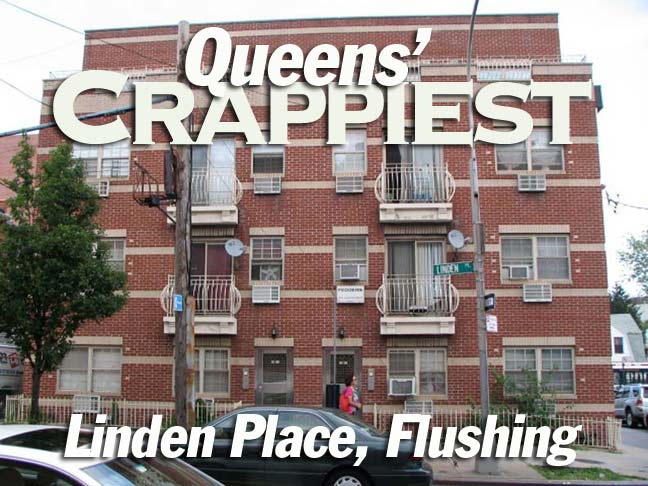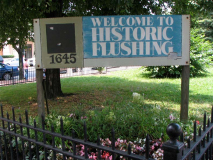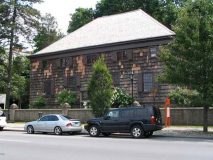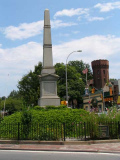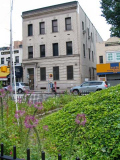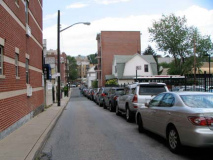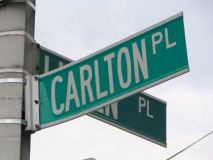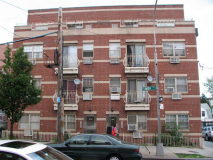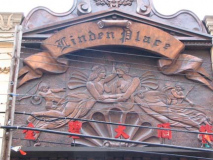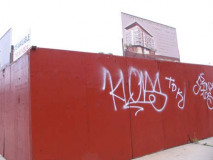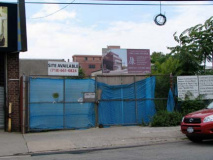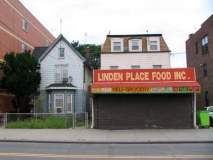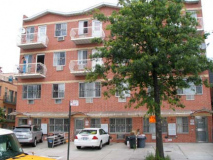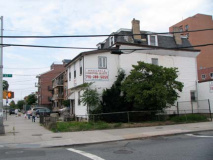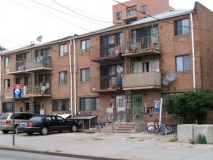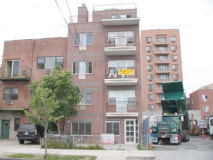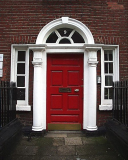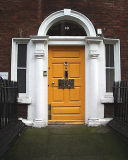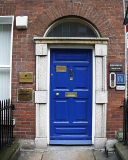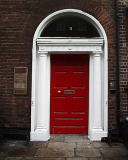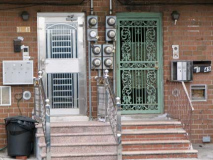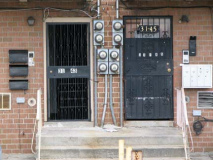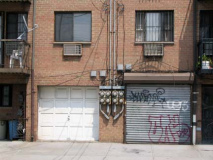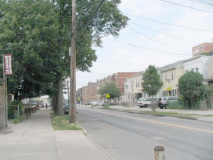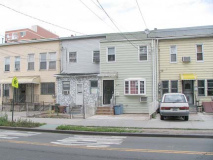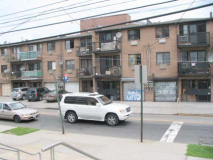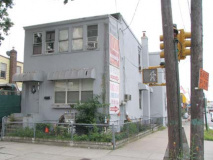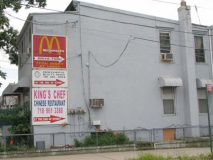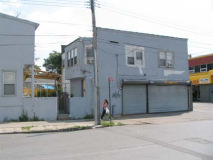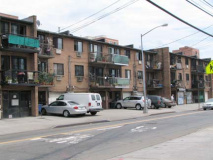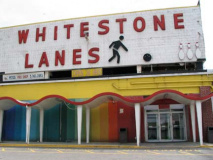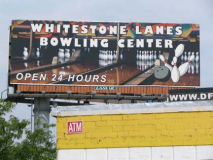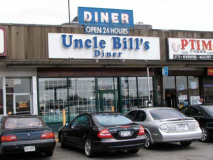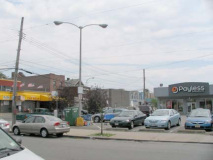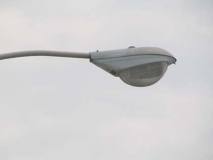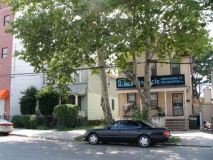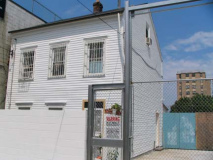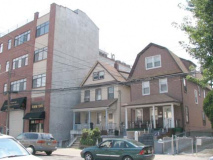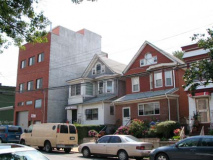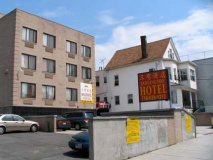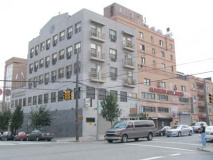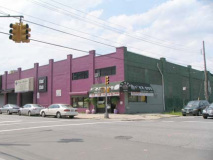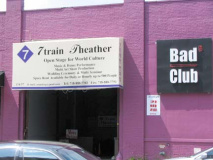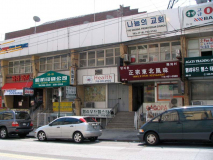The interesting thing is, Linden Place begins extraordinarily promisingly — as you begin at Northern Boulevard, you find yourself at several centuries-old landmarks that have somehow, somehow survived in Flushing despite its relentless overurbanization over the decades. The moment you start walking north on Linden Place, though, you quickly find yourself in what can alternately be described as one of the most distilled, honed concentrations of garbage architecture you could ever find in NYC; or a Bloombergian urban necessity: our mayor’s prediction is that there will soon be 9 million New Yorkers, and they will all have to go someplace.
There’s Flushing Town Hall, built in 1862 and lovingly restored in the mid-1990s; Friends Meetinghouse, used as a place of worship nearly continuously since 1695…
There’s an 1865 Civil War memorial and a telephone exchange building constructed in 1915.
But I discuss all that on my Flushing ForgottenTour (#21) page and my Northern Boulevard page … we’re here for the crap architecture, after all, and it will begin to be dished out very soon.
Just north of Northern Blvd, a narrow alley called Carlton Place runs east between Linden Place and Leavitt Street. It’s lined, at least on the north side, with small frame houses that must have been much more common in Flushing until just a short time ago. On the south side, here’s a gabled house with an out-of-context 3-story building right next door. This sort of thing happens a lot in Flushing, where there aren’t any regulations to prevent it.
Bring in da’Noise, bring in’da Crap!
What you’ll see here lining Linden Place between Northern Boulevard and the Whitestone Expressway is almost exquisitely bad, the pinnacle of cheap, slapped together architecture. Sorry to sound like a snob about this but, well, I am a snob about this. You’ll hear that this is what people can afford to rent or buy and this is what developers can afford given the amount of units they have to produce. Nonsense because developers prior to 1970 or so were able to build multi-unit apartment buildings that weren’t esthetic disasters, like this.
Developers and real estate professionals who read FNY: you tell me why the balconies have to be made of steel that rusts immediately after installation; why gas meters have to be mounted right beside the front door; why foliage of any type, grass, trees, flowers, is verboten; why any verve, flair or ornamentation is forbidden. Give me answers, and I’ll show them right here.
Linden Place has gotten so bad, as a matter of fact, that the auto parts store on the corner of 35th Avenue and the Latimer Gardens housing project have to be considered favorably just because they break up the monotony of one Fedders Special after the other. Latimer Gardens is named for Lewis Latimer (1848-1928), the African American inventor of the light bulb filament and a chief aide to Alexander Graham Bell. Latimer and his family lived in this house in Flushing from 1903 to his death in 1928.
A relatively new development, Latimer Gardens was opened in September 1970.
This catering hall across from Latimer Gardens, known rather prosaically as Linden Place, is over the top considering its surroundings. It has gotten favorable and unfavorable reviews.
Recent teardowns and empty lots feature renderings of the buildings their developers would like to build.
A pair of older buildings on Linden Place. Even the one on the right has been crappified, with a brick storefront built in front of the original frame residence. Immediately to the north is a modern brick building.
LEFT: Linden Plaza Condominiums. Crowne Plaza, it ain’t. RIGHT: on 32nd Avenue, a frame building with a mansard roof has a for sale sign. Fresh crap coming soon!
The hallmarks of classic Queens crap. Cars parked in front, meters by the door and rusted-out balconies. RIGHT: the dump truck adds some antiesthetic reinforcement.
100,000 Welcomes
They say the Emerald Isle is the land of Céad Míle Fáilte, or Ten Thousand Welcomes. The expression may have come about in some part because of the myriads of beauteous, colorful ornate doorways of Dublin townhouses:
Well, fab Flushing is the land of plenty of welcomes, too, especially on Linden Place!
Dublin ain’t got nothin’ on Flushing’s barred windows, gas and water meters and lovingly fashioned chrome doors.
Rare trees. A stretch between 32nd Avenue and 31st Road has a grassy strip by the curb and a stray arbor here and there. Some older homes have been made thoroughly crapworthy with questionable siding stylings.
An office building rises out of nowhere at 31st Road; its tenants are unmarked on the exterior, its face inscrutable and unknowable. What do its unknown desk jockeys see out those wraparound windows?
More slices of steaming Linden Place Queens crap.
On the southeast corner, a cluster of buildings have resisted the irresistible! They’ve steadfastly refused to sell and are holding fast against the rising stain of crap!
The God of Commerce has had its demands answered on the 31st Road side, where big arrows and the golden arches point to the gargantuan shopping mall a couple of blocks to the west.
Linden Place, crap till the last, finally dumps its traffic onto the Whitestone Expressway north of 31st Road. Linden limps on to the remains of Flushing Airport, ending at 28th Avenue.
With the recent closure of Woodhaven and Van Wyck Lanes, is Whitestone Lanes, Whitestone Expressway and Linden Place, the only bowling alleys left in Queens?
ForgottenFan Tom Testa: You asked about bowling alleys in your Linden Place, Flushing page. There is a working alley at 98 -18 Rockaway Blvd. in Ozone Park called the Cozy Bowl or Cozy Alley. It is sandwiched between a White Castle and the A Train El as it heads south toward Rockaway Beach.
Laura “Marathon Mom” Healy: Also happy to report that the 34th Ave. Lanes (at 69th Street) in Jackson Heights (down the street from where I spent most of my formative years, and where I held my 10th birthday party 40 years ago!) is still alive and well….
There’s also Jib Lanes, Electchester in Flushing
Farrington Street
Turning left at Whitestone Expressway and then south again on Farrington, I found a street with more reminders of a more pleasing past, but developing rapidly and beginning to squeeze them out…
I did tarry a short while at the huge mall at the end of 31st Road, where I found Uncle Bill’s diner and a very rare occurrence of the GE M1000 luminaire. They resemble the bigger, badder brothers of the GE M400, which used to be in passenger-pigeon like numbers in NYC.
More GE M1000s here…
Farrington Street is a mixed bag…in its northern stretch shown here, there are factory buildings and older little frame houses that are hanging on by their fingernails.
But the realities of modern-day Flushing are ever ready to encroach.
Farrington Hotel, and a structure at 35th Avenue that does not deign to sign in English.
An older building at 35th and Farrington — I can’t identify its purpose — has been painted purple and green, like Barney. There is a theater and a Bad Club in the building.
Farrington, just north of Northern Bouelvard. I have no words; I’ll let H.P. Lovecraft, who could describe horror like no other writer, make an allusion; here’s his description of the inhuman Wilbur Whateley from “The Dunwich Horror”:
It would be trite and not wholly accurate to say that no human pen could describe it, but one may properly say that it could not be vividly visualized by anyone whose ideas of aspect and contour are too closely bound up with the common life-forms of this planet and of the three known dimensions. It was partly human, beyond a doubt, with very manlike hands and head, and the goatish, chinless face had the stamp of the Whateley’s upon it. But the torso and lower parts of the body were teratologically fabulous, so that only generous clothing could ever have enabled it to walk on earth unchallenged or uneradicated.
Moving forward from Lovecraft a few decades, I’ve come to the conclusion that Johnny Rotten was wrong when he said there’s “no future for you.” There is a future for Queens, and what we’ve seen on this page is that future.

